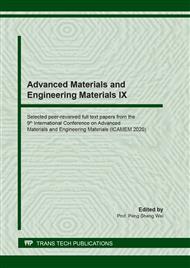[1]
Y. Yoshizawa, S. Oguma and K. Yamauchi: J. Appl. Phys. Vol. 64 (1988), p.6044.
Google Scholar
[2]
Y. Yoshizawa and K. Yamauchi: Mater. Sci. Eng. A Vol. 133 (1991), p.176.
Google Scholar
[3]
K. Hono, A. Inoue and T. Sakurai: Appl. Phys. Lett. Vol. 58 (1991), p.2180.
Google Scholar
[4]
A.L. Beľtyukov, A.I. Shishmarin and V.I. Laďyanov: High Temperature Vol. 53 (2015), p.302.
Google Scholar
[5]
V. Tsepelev, Yu. Starodubtsev and V. Konashkov: EPJ Web Conf. Vol 151 (2017), 04006.
Google Scholar
[6]
P.S. Popel and V.E. Sidorov: Mater. Sci. Eng. A Vol Vol. 226–228 (1997), p.23.
Google Scholar
[7]
U. Dahlborg, M. Calvo-Dahlborg, P.S. Popel and V.E. Sidorov: Eur. Phys. J. B Vol. 14 (2000), p.639.
DOI: 10.1007/s100510051073
Google Scholar
[8]
P.S. Popel, M. Calvo-Dahlborg and U. Dahlborg: J. Non-Cryst Solids Vol. 353 (2007), p.3243.
DOI: 10.1016/j.jnoncrysol.2007.05.179
Google Scholar
[9]
M. Calvo-Dahlborg, P.S. Popel, M.J. Kramer, M. Besser, J.R. Morris and U. Dahlborg: J. Alloys Comp. Vol. 550 (2013), p.9.
DOI: 10.1016/j.jallcom.2012.09.086
Google Scholar
[10]
P.S. Popel. U. Dahlborg and M. Calvo-Dahlborg: IOP Conf. Ser.: Mater. Sci. Eng. 2017. Vol. 192 (2017) 012012.
DOI: 10.1088/1757-899x/192/1/012012
Google Scholar
[11]
O.A. Chikova, V.S. Tepelev and O.P. Moskovskikh: Russ. J. Phys. Chem. A Vol. 91 (2017), p.979.
Google Scholar
[12]
B. Dong, S. Zhou, J. Qin, S. Pan and Z. Li: Chin. Mater. Res. Soc. Vol. 23 (2013), p.216.
Google Scholar
[13]
S. Zhou, B. Dong, R. Xiang, G. Zhang, J. Qin and X. Bian: Prog. Nat. Sci.: Mater. Inter. Vol. 25 (2015), p.137.
Google Scholar
[14]
V. Tsepelev, V. Konashkov, Y. Starodubtsev, Y. Belozerov and D. Gaipisherov: IEEE Trans. Magn. Vol. 48 (2012), p.1327.
DOI: 10.1109/tmag.2011.2175209
Google Scholar
[15]
S. Glasstone, K. Laidler and H. Eyring: The theory of rate processes. The kinetics of chemical reactions, viscosity, diffusion and electrochemical phenomena (McGraw Hill, 1941).
Google Scholar
[16]
J. Frenkel: Kinetic theory of liquids (Сlaredon Press, 1946).
Google Scholar
[17]
V. Tsepelev, Yu. Starodubtsev, V. Konashkov, K. Wu and R. Wang: J. Alloys Comp. Vol. 790 (2019), p.547.
Google Scholar
[18]
A.I. Batschinski: Z. Phys. Chem. Vol .84 (1913), p.643.
Google Scholar
[19]
B.A. Baum: Metal liquids (Nauka, Moscow, 1979).
Google Scholar


